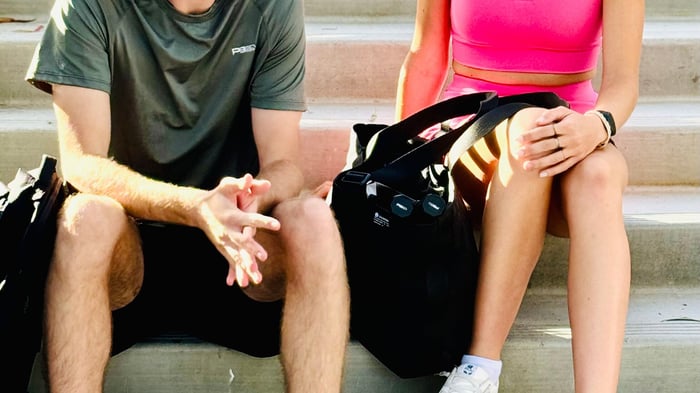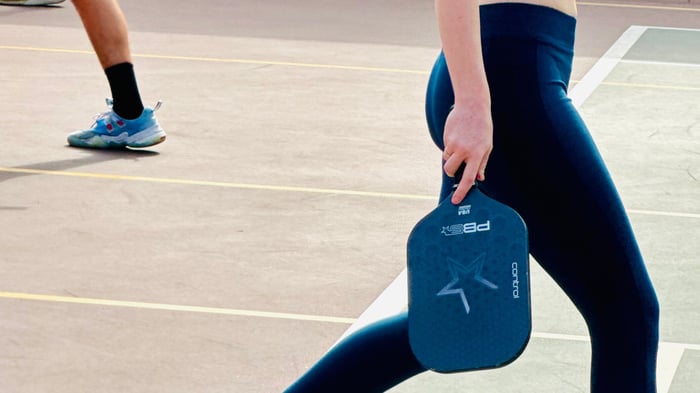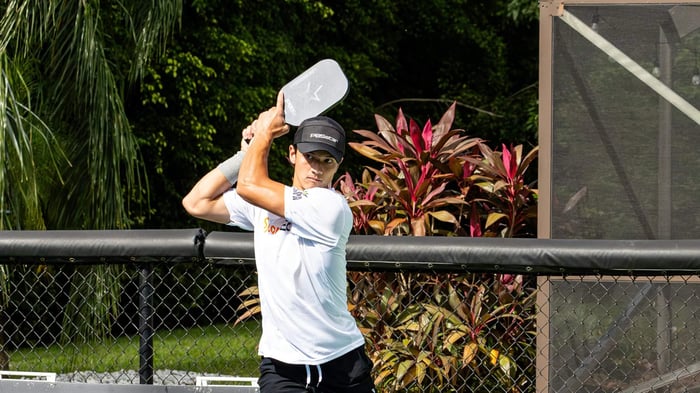Key takeaways:
Enhance your pickleball game by using video analysis to identify and improve your technique, footwork, and strategy.
Utilize multiple camera angles, slow-motion playback, and specialized apps to gain deeper insights into your performance.
To make steady, lasting improvements in your game, stay consistent with your video reviews and focus on one area at a time.
Video has become one of the most valuable tools for athletes across every sport, and pickleball is no exception. Whether drilling or playing a full match, recording yourself gives you a front-row seat to your performance and helps turn practice into something more intentional. It’s not about watching highlight reels, it’s about using your footage to grow.
Adding video to your routine helps you play with more awareness, purpose, and control. Instead of relying on feel or memory, you can see your game clearly and make more intelligent choices based on what happens on the court. This kind of visual feedback turns everyday practice into a powerful learning opportunity. At PB5Star, we’re all about giving players the tools and techniques to use video effectively and improve with every session. The right apparel and gear also help you play your best, comfortable, confident, and game-ready.
Why video is a game-changer
There’s often a gap between how something feels on the court and what’s happening; video helps bridge that gap. You might think your paddle is in the ready position, or that your footwork is smooth and reactive, but video can reveal otherwise. It takes the guesswork out of improvement by showing you exactly what you're doing in real time.
Watching yourself play also helps you spot patterns you may not notice in the moment. Your grip shifts under pressure, or you step too late when approaching the net. These small details are easy to overlook when focused on gameplay, but video makes them clear. Over time, reviewing footage not only boosts self-awareness, it also gives you something to measure against. You can track progress, reinforce good habits, and stay motivated by seeing your growth on screen.
What to look for on camera
When you start recording your pickleball sessions, it’s easy to feel overwhelmed by all the movement on screen. It helps to know exactly what you’re looking for to get the most out of your footage. Focusing on key areas like footwork, paddle position, and court awareness helps you spot habits that need adjusting and track your progress over time. Many players in the forum recommend watching playback with this in mind. Here are some critical elements to pay attention to during the review.
Footwork and movement patterns: Clean, efficient footwork is key to staying balanced and responsive during rallies. Look for signs of hesitation, flat-footedness, or extra steps that take you out of the ideal position. Consistent movement can distinguish between chasing the ball and being there early.
Paddle position and grip: Maintaining a consistent paddle height and grip throughout play helps you stay ready for fast exchanges. Dropping the paddle or letting your grip shift can lead to late reactions or mishits. Reviewing video can reveal moments where these habits slip under pressure.
Shot selection and execution: Wise shot choices, whether a soft dink, a deep return, or a drive, are essential for controlling points. Video helps highlight if you’re rushing, forcing shots, or missing opportunities to reset and regain control.
Court positioning and transitions: Smooth transitions between positions, like moving from baseline to the kitchen line, keep you competitive during rallies. Watch for spacing between you and your partner, and whether you're recovering to the right spots after each shot.
Body language and recovery time: Confident body language and quick recovery help maintain momentum and rhythm. Video can uncover subtle cues like slumped shoulders, hesitation after a missed shot, or slow resets. Staying physically and mentally alert between points is as important as shot execution.
The more you review these specific elements in your footage, the easier it becomes to recognize patterns and make meaningful improvements. With consistent focus and a trained eye, video turns from just a replay into a powerful tool for refining your technique and sharpening your overall game.
Effective video techniques for mastering pickleball
Recording your pickleball game is a significant first step, but using that footage makes all the difference. With the proper techniques, video becomes more than just a replay; it becomes a powerful tool for learning, correcting, and leveling up your skills. Whether you're analyzing solo practice or full matches, these methods can help you get real value from every clip.
Use multiple camera angles: Recording from different perspectives, such as behind the baseline, side court, or a diagonal corner, gives you a fuller view of your movement, positioning, and shot execution.
Take advantage of slow-motion playback: Watching footage in slow motion allows you to break down the fine details of your technique. You’ll see precisely how your paddle moves through a swing, when your foot plants during a shot, or how quickly (or slowly) you react.
Apply frame-by-frame analysis: Step through your video one frame at a time to pinpoint the exact moment something goes right or wrong. Whether tracking contact with the ball or seeing how quickly you reset, frame-by-frame viewing gives you precision feedback that can lead to smarter corrections.
Focus on one element at a time: Instead of analyzing everything individually, pick a single aspect to focus on. Zeroing in on one thing makes your review more effective and helps you apply changes with greater clarity and confidence.
Explore video analysis apps and tools: Apps like Coach’s Eye, Hudl Technique, or OnForm let you draw on the screen, compare clips side by side, and even get coach feedback. These tools can turn basic footage into a powerful learning experience by helping you visualize your progress and highlight key improvements.
Incorporating these video techniques into your practice routine can fast-track your progress and sharpen your awareness on the court. By reviewing with intention and focus, you'll start spotting patterns, correcting mistakes, and gaining a deeper understanding of your game.
Reviewing your footage / turning video insights into action
Reviewing your footage helps to go in with a clear intention. Instead of analyzing everything individually, choose one area to focus on during each session: your footwork, paddle position, or shot placement. This keeps the process manageable and more effective. Watch for repeated patterns or breakdowns that might affect your consistency as you watch. You can also learn a lot by comparing your clips to higher-level players or even past recordings of yourself to see how your game evolves.
Once you’ve spotted a few key areas for improvement, the next step is turning those insights into action. Make a short list of specific things to work on, then head into your next practice with those focus points in mind. Targeted drills are excellent for isolating problem areas and reinforcing better habits. After a few sessions, re-record yourself to check in on your progress.
Frequently asked questions (FAQ) about recording pickleball games
Getting started with video can initially feel a little unfamiliar, especially if you’ve never recorded your play. But once you know what to focus on, it becomes one of the most helpful tools in your training routine. To make things easier, here are some of the players' most common questions about recording, reviewing, and using video to improve their pickleball game.
What’s the best way to record my pickleball game without fancy equipment?
You don’t need anything high-end to start; your smartphone and a tripod or paddle mount will do the trick. Set it up at the baseline or side of the court for a wide, clear view. If you're solo, a portable tripod and a wall drill are simple ways to film practice.
Which angle should I use to get the most useful footage?
Recording from behind the baseline gives you a great view of court positioning, footwork, and shot execution. A side view is also helpful for seeing paddle motion and body mechanics. Mix it up to get a more complete picture of your game.
How long should I record my pickleball play for a useful analysis?
You don’t need to film an entire session. Even 10–15 minutes of game play or focused drills can reveal valuable insights. Pick a short segment, then review it with one goal, like checking your ready position or how you transition to the kitchen.
How often should I record and review my pickleball play?
Once a week is a solid rhythm for most players, especially if you're working on specific improvements. Regular review helps reinforce good habits and catch minor issues before they become major setbacks.
Video might seem like a small addition to your routine, but it can lead to significant breakthroughs when used consistently. The more comfortable you become with recording and reviewing your play, the easier it becomes to spot progress, adjust your technique, and confidently grow your game.
Why PB5star gear enhances your video training sessions
From casual players to serious competitors, anyone can benefit from watching their game with a focused eye. The key is consistency, curiosity, and a willingness to make minor improvements each time you play. The more you commit to reviewing your game, the faster you’ll see results in your form, strategy, and overall performance.
At PB5Star, we’re here to support that process, not just with training tips, but with thoughtfully designed apparel and gear that helps you move freely, stay comfortable, and focus during every recorded session. When you feel your best on the court, it’s easier to train your best, which shows up in every frame of your progress.







